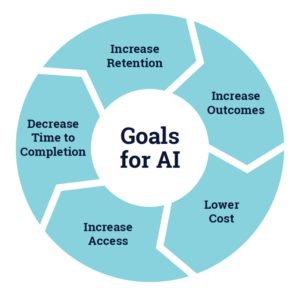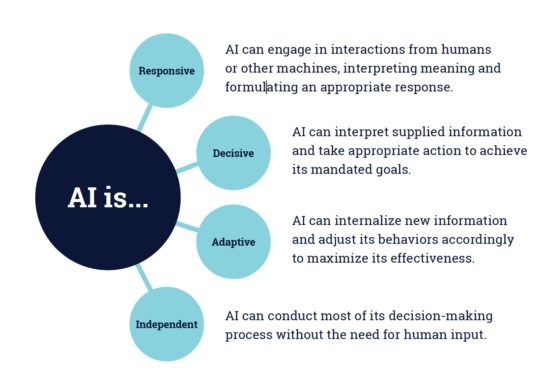Klutka, J. et al. (2018) Artificial Intelligence in Higher Education: Current Uses and Future Applications Louisville Ky: Learning House
This report is by Learning House, an online program management service recently acquired by John Wiley and Sons. The authors surveyed four key areas in higher education and the opportunities for growth in the near and distant future.
What can AI do?
The report provides a general definition of AI, which is not so much a definition as a categorization of what it can do:
The main advantage that the authors identify for AI is that it opens up the possibility for higher education services to become scalable at an unprecedented rate, both inside and outside the classroom. In particular they claim that it can handle many of the routine functions currently done by instructors and administrators, freeing them up to solve more complex problems and connect with students on deeper levels.
Four application areas in higher education
They identify four key areas for applications of AI in higher education:
- student enrolment and acquisition
- learning and instruction
- proactive students services (counselling, program guidance, etc.)
- institutional efficiency (cross-institutional and external data gathering and analysis)
Examples of applications
The report provides many examples of actual AI applications in higher education. I list just a few below.
Student enrolment and acquisition
AdmitHub: This app for mobile phones provides potential applicants with automated responses to commonly asked questions when applicants are trying to decide whether or not to enrol in a particular college or university, or once enrolled, how to find their way around the system, such as paying library fines, the procedure for dropping a course, or ‘nudging’ students to complete tasks, etc. It links students directly to the appropriate ‘human’ where necessary. It is being piloted at Georgia State University.
Learning and instruction
ECoach, developed at the University of Michigan, provides formative feedback for a variety of mainly large classes in the STEM field, using something very much like an LMS to provide weekly tasks and links between content and possible exam questions. It tracks students progress through a course and directs them to appropriate actions and activities on a personalized basis.
M-write, also developed at the U of Michigan and used in conjunction with Ecoach, is one of several AI programs that uses peer review, in this case in conjunction with automated text analysis based on instructors’ rubrics for answering questions.
Other applications listed in the report include sentiment analysis (using students’ facial expressions to measure their level of engagement in studying), an application to monitor student engagement in discussion forums, and organizing commonly shared mistakes in exams into groups for the instructor to respond once to the group rather than individually.
Proactive student services
Stellic enables students to create degree plans based on career templates of former students, project the effects of plan changes on their graduation rate and communicate changes to academic advisors.
Ask SLU is an Alexa-based virtual assistant for students at St. Louis University, which has provided Alexa hubs all round the campus for students to use.
Institutional efficiency
Genie is a voice controlled smartphone app designed at Deakin University (Australia) to ensure its students feel supported, organised and in control throughout their studies. The system learns as it answers more student inquiries.
Challenges
The report looks at some of the barriers to more effective use of AI. In particular the authors argue that changes will be needed in the following areas:
- accreditation and financial aid to better support the use of AI
- privacy regulations such as FERPA need to be updated in order to address the ability of AI systems to track data and use it for predictive analytics.
Comment
This is a very useful report, mainly because it provides specific examples of how AI is actually being applied in higher education. As always, if this post raises interest or concerns, please read the actual report.
However, I have to say I was hugely underwhelmed by what I saw, not just in the report but in the applications themselves (although I would prefer to have direct experience of using these applications). There are several reasons for my lack of enthusiasm:
- many of them look clunky and very much like the very early stages of a new technology and best avoided until more sophisticated applications are available;
- in particular they don’t get to the heart of the educational enterprise which is teaching and learning. They are mainly support systems and as such have some value, but they do not live up to the hype that surrounds AI; applications such as these are not going to revolutionize education although they could in the long run make it a little more efficient;
- many of these applications were not particularly intelligent in the sense that they were working at very routine levels of activity; they were more like technology-enhanced applications rather than ‘true’ artificial intelligence.
This judgement is based strictly on their technical merits; it does not begin to look at some of the ethical and ideological issues around the use of AI in education – but that’s for another post.











 Dr. Tony Bates is the author of eleven books in the field of online learning and distance education. He has provided consulting services specializing in training in the planning and management of online learning and distance education, working with over 40 organizations in 25 countries. Tony is a Research Associate with Contact North | Contact Nord, Ontario’s Distance Education & Training Network.
Dr. Tony Bates is the author of eleven books in the field of online learning and distance education. He has provided consulting services specializing in training in the planning and management of online learning and distance education, working with over 40 organizations in 25 countries. Tony is a Research Associate with Contact North | Contact Nord, Ontario’s Distance Education & Training Network.

